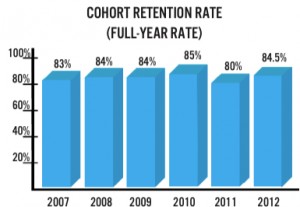Finances a factor in some students’ decision to leave Concordia

Though Concordia has seen slowly shrinking enrollment numbers, the retention rates tell a different story.
Mike Reese, Director of Student Success and Retention Services, said the average retention rate from fall to spring semester averages from 93-96 percent. This year is no exception; 94 percent of students from the fall semester have continued their education at Concordia.
“It’s down a little bit,” Reese said. “It’s still a good rate.”
Cohort retention rates, or fall to fall retention rates, have steadily increased over the years. In 2007, 79 percent of students stayed at Concordia. In 2008, that number jumped to 83 percent. The rate rose due to the creation of services such as the Student Success and Retention Services, the Peer Mentor program, Personal Student Support, Outreach and Drop-in Services, Parent and Education Support, Retention Management Strategies, and Information and Referral. The services provided a sharper focus on encouraging students to stay.
In 2011, the rate dropped by 5 percent from the previous year, then rose by 4.5 percent in 2012.
“It is incredible the bounces we have made after a drop in retention,” Reese said. “There are colleges that would be just elated to do that. Everybody on this campus should pat themselves on the back and say ‘well done.’”
The average number of students who leave between fall and spring semester is around 40-60 students but the drop of students that leave are balanced by the amount that transfer to Concordia for spring semester.
Students transfer for a number of reasons. One reason students leave is because they don’t feel at home at the school.
“They just don’t feel like it’s meant for them,” Reese said. “‘I don’t like my roommate, I don’t like my classes, I don’t like my advisor or the people walking around campus, it’s too conservative.’”
Junior Ben Gislason transferred from St. Olaf to Concordia this fall.
“One thing that made me transfer was that as a whole, St. Olaf was a really entitled place. A lot of people were really self-involved,” Gislason said. “You meet a lot more grounded people here. They take care of themselves but are also genuinely interested in others.”
Another reason students transfer is due to lack of major. Reese has seen students leave because they can’t receive majors like criminal justice, hospitality management, audiology, music therapy, and speech therapy.
Donovan Chock, previous student of Concordia, left for St. Scholastica this fall because Concordia does not offer a Computer Information Systems major.
“I don’t regret transferring,” Chock said. “I now have new perspectives and there are plenty of things for me to take away.”
St. Olaf did not offer a journalism major, the main reason why Gislason transferred.
“They had a way you could make your own major, and I was halfway through when I realized that it wasn’t a realistic option,” Gislason said. “I needed to go somewhere that had a journalism program. Concordia has a good program.”
That has made all the difference for Gislason, who feels Concordia holds more emphasis on real-world application.
“It has been a revelation that I have been taking classes where I feel like I am learning skills that are necessary for what I am going into,” Gislason said. “While I was at St. Olaf, I could memorize a soliloquy of Shakespeare, but if I were to go on the news and talk about that, I wouldn’t get hired by anybody.”
Reese said financial issues, distances from home and personal preferences such as moving to get closer to a significant other are other reasons Reese has seen students leave Concordia.
Though Chock misses some aspects of Concordia, he enjoys the change of scenery from the Mid-western farmland.
“I miss the music, my friends, DS, and the Concordia atmosphere,” Chock said. “I enjoy the opportunities Duluth has to offer though. I’ve gone hiking, winter camping up the North Shore, sailing and more.”
Reese said students usually transfer to less expensive state schools such as North Dakota State University, Minnesota State University Moorhead and University of North Dakota.
“Only a small handful actually transfer to another private university,” Reese said.
Former student Alec Iorio said the price of Concordia was too much, even with student loans. He now lives in Hibbing and expects to attend UMD.
He also said core classes left him too little time to study music.
“All in all, [Concordia] is a great school and the music department is wonderful,” Iorio said. “I understand core classes, but I feel they’re too time consuming.

